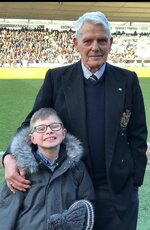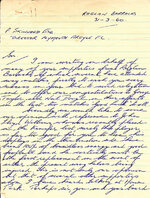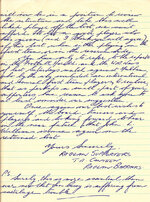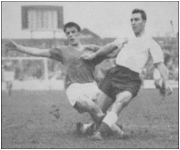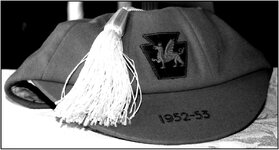Although I knew he had not been well for some time, it was nevertheless still a great sadness to be told of the passing of John Lloyd Williams, better known at Home Park as John ‘Cardiff’, a reference to his time at Ninian Park prior to joining Argyle in the summer of 1958.
During the research for my book about the 1958-59 promotion season, I had the good fortune to meet most of the surviving players, 50 years on from the time they were my early heroes. Sometimes I feel like a broken record when I tell people how pleasant and humble they all were, pleased to help me with their time and to afford me hospitality. But in John’s case ‘pleasant and humble’ does not nearly cover it. As this thread shows pride, respect, fondness, inspiring are all mentioned. He was just a very special man.
After several telephone conversations, in early 1958 I travelled to his home in Merthyr Tydfil. His memorabilia was laid out, ready for inspection, the medal still boxed and his youth international cap neatly wrapped in tissue paper as well as being boxed as well. Tea and biscuits quickly appeared as he made me welcome. His hair was now silver and he sported a moustache, but in terms of build, it was surprising how little John Lloyd Williams has altered in half a century. He had hardly gained an ounce in weight and looked the picture of health. It was no surprise that he was still running 10 miles a week and in the past few years he had competed in two London marathons, the Welsh half marathon and the Great Cardiff Run. All this in addition to collecting trollies in the Merthyr Asda Superstore for 13 hours a week, a job where he was immensely popular with both colleagues and shoppers.d
That meeting in Merthyr formed the basis of the chapter I wrote about him. I know it makes a long post but I have decided to include much of it here, altering the tense as necessary. It was a fascinating day and because I found him so interesting I found it difficult to edit too much of it out.
John was born on 27 January 1936, in Rhymney, South Wales, a town immortalised by poet Idris Davies in his ballad The Bells of Rhymney. It was a powerful piece, set to the melody of ‘Oranges and Lemons’, about the effects on the area of the 1926 General Strike and the Great Depression. By the time he was born, the worst had passed, though many still lived in poverty. With his mum, dad and older sister Margaret, he lived in his maternal grandfather’s house. He remembers a secure and happy childhood. He told me how his father, one of 18 children, would work a nine-hour shift in the local pit, something he did for 45 years. Until the 1948 nationalisation of the coalfields there were no pit-head baths or showers. John remembers his dad sitting in the kitchen in a tin bath filled with hot water, washing the grimy black dust from his body.
War was declared as John neared his fourth birthday. As it ended, he had progressed from Upper Rhymney School to the local secondary school. John was such an outstanding footballer that he came to the attention of the Welsh Youth team selectors, no mean feat for a boy who had rarely ventured out of Rhymney. Unlike some of the other players, he was not attached to the ground staff of any professional club, though he had played for Tredegar Schoolboys.
At just 16 years old he was selected to play against England Youth at Fratton Park. Wales went down 3-1, with John scoring their goal. He cannot recall anyone else in the Welsh side becoming a professional. In the England side he remembered Jim Iley, who later played for Sheffield United, Forest, Newcastle, Spurs and Peterborough and Geff Cox who later played for Torquay and Cardiff City. Indeed Cox was back at Torquay when John arrived from Argyle.
After his excellent display against England, Hull City came in for him. After a trial he was offered terms, but his mother would not hear of him moving so far. Cardiff City (then in the First Division) showed an interest and on his 17th birthday he signed professional terms for £6 per week. He could not speak highly enough of Alf Sherwood, a senior professional at Ninian Park. Despite being a first team player and a Welsh international, Alf helpful and kind to the young man. John was able to live at home, travelling to Cardiff by train each day on a £1 weekly return ticket, paid for by the club.
Joining Cardiff meant leaving behind the job his uncle had found him in the Rhymney Brewery. He had planned to be a carpenter but that meant delaying National Service until he had completed the apprenticeship. He was called up at 18, joining the Royal Army Service Corps and spending the majority of his time in Bielefeld in Germany. Although he played football while in the Army he did not serve with any other professionals. John regrets never being tasked with any assignments to Berlin, but he did visit Belsen, something he describes as too horrible ever to forget. He also recalledbeing confined to barracks for two weeks when the Germans were celebrating after formally being given back their freedom.
Demobbed in 1956, it had been a crucial time for his career to be interrupted, but he took up where he left off and again became a regular in Cardiff’s Football Combination side. Both first team wing-halves were internationals and there was another waiting in the reserves. After two years he asked manager Trevor Morris for a transfer. Towards the end of the 1957-58 season Morris told him that Norwich City were interested in signing him.
Norwich were about to play a friendly against Leicester, and their manager Archie McCauley was keen for John to play in it. John travelled to Norwich and acquitted himself well, in what was virtually the Canaries’ first team. He remembered Johnny Newman being in the opposition that night. Williams liked Norwich and Carrow Road. He would cost £4,000 and the manager wanted him. He returned to Cardiff and told Morris he wished to join the East Anglian club. But while he had been away, Plymouth had expressed an interest. John travelled to Devon, spoke to Ron Blindell and Jack Rowley, leaving with a transfer form given to him by the Argyle boss.
Rowley told him that if he wanted to join the Home Park staff he should just sign it and post it back. Argyle offered better terms, understanding that John would need to live in ‘digs’ if he signed for them. What John never understood is that Argyle offered only £3,000, yet Morris was keener for him to go to Devon. He was told that if he signed for Plymouth, Cardiff would pay a £300 benefit but if he went east, that offer would be withdrawn. The benefit payment swung it and Argyle now had a second John Williams on their books.
With Tom Barrett injured John made his debut against Bury on Thursday 18 September 1958 and kept his place for the next 14 games, before losing out to new signing Len Casey. His spell out of the side included the third round home FA Cup tie against his former club Cardiff. He was devastated at missing that game, a disappointment he still felt when we met. It was March before he regained his place, in an evening match at Tranmere. Johnny Williams was moved forward to inside right and John ‘Cardiff’ replaced him at wing half. Argyle lost 2-0 but the side played better than they had for weeks. However, he was left out for the next two games, a 2-0 success at home to Chesterfield and a 3-0 defeat at Brentford on Good Friday.
As the party left Griffin Park, bound for South Wales and an Easter Saturday encounter with Newport, John felt that he could be recalled at Somerton Park. It was the landlord of his Plymouth digs (and not Jack Rowley) who told him he was in the side. He had come up for the match, travelling with director Cliff Crookes, who because the manager’s selection had to be cleared with the Board, knew John would be included. As John passed a ticket to his landlord, he told him he was in the side.
He was glad he played, for his parents came down from Rhymney to watch, as did one of his old secondary school teachers. John reckoned that his father gained as much pleasure from being introduced to Jack Rowley as he did from watching his son play in the match. For John, his own day was made when Alf Sherwood, by then plying his trade at Newport, came to the Argyle dressing room and sought him out, telling him, “I am so pleased for you son, that you have made it into someone’s first team. Good luck for the future, you deserve it.” He retained his place for the remaining seven fixtures. He can still remember the wonderful feeling of securing promotion at Accrington, the scenes the next day in the city and at Home Park. Thousands had turned out. Then on the following Wednesday the 1-1 draw with Bradford City nailed the championship and the celebrations kicked off again.
At the start of the season Jack Rowley, a man John admired immensely, had advised him that he was being signed as cover for injuries, so to play in more than half of the 46 fixtures represented a successful first season. Although John remained at Home Park for another three seasons, he could never establish himself in the side. With Len Casey already on the books, he was pushed further down the pecking order when Johnny Newman arrived from Leicester City. He only made ten more first team appearances in the League, another three in the FA Cup and two in the League Cup.
But he played in some quite memorable games. He twice played at Anfield, both times in direct opposition to Roger Hunt. He also has cause to remember the 0-0 draw against Aston Villa in the League Cup, a match which was unusual for being abandoned after 90 minutes. The referee ruled the ground unfit for extra time to be played. After the game Gerry Hitchens, the Aston Villa centre-forward and a full England international, came to look for him after the match. They had been at Cardiff together. In his typically modest way, John told me that he didn’t go looking for Hitchens because he thought he wouldn’t remember him.
On the first Saturday in March 1961 John was included in the side to face Leeds at Home Park. Jim McAnearney was injured so Johnny Williams moved from wing half to inside forward. John replaced him at right half while inside forward Alex Jackson continued on the right wing. John remembered it as if it were yesterday. “We was none each half-time. We seen the chairman, Mr Blindell, come to the dressing room door. He called George Taylor outside and when George come back he made the changes. Johnny went back to right half, Jacko moved outside and I was put on the wing. We thought it would be a secret but it was all over the papers the next day. Mr Blindell took the credit when we won but said he would have took the blame if we lost 5-0.” A Wilf Carter hat-trick ensured Blindell’s changes secured a 3-1 win, with a pin-point free kick from John allowing Wilf Carter to head Argyle into a 2-1.
However, it was whilst playing for the reserves that John Lloyd Williams made national news, with his photo appearing on every back page. On 9 December 1961 Tottenham reserves were due at Home Park. During the week prior to the game Spurs signed Jimmy Greaves from AC Milan. He could not be registered in time to play in the First Division, so he was included in the Football Combination fixture at Plymouth. John Lloyd was Argyle reserves’ left half and would be given the task of marking Greaves.
In the event John played very well, watched by more than 12,000 supporters and famous journalists like Clive Toye, Ian Wooldridge and Clement Freud. He drew great praise for his tenacious and dogged display, despite Greaves scoring twice. At one stage, so close did Williams stick to his task, he ended up accidentally getting Greaves’s boot in his face. Greaves was the first to his side to check that he was all right. As the players left the field for half-time, Greaves was asked to make the draw. John doubtless stayed with him for that too.
In the 1961-62 season, his final two games in an Argyle first team saw him join Johnny and Keith Williams to complete a trio of Williams, the only times Argyle have fielded three players with an identical surname. At the end of the season he moved to Plainmoor, where he spent three seasons and played in 42 League games.
Unusually, although he was no longer in Ellis Stuttard’s first team plans, John could have stayed. He had already been retained for two seasons, mainly because of the job he was doing for the reserve side, setting a fine example to the younger players with his sharp football brain, dedication to fitness and sober lifestyle. Stuttard was happy to continue that idea but John preferred to join his good friend Peter Anderson at Plainmoor. Former colleague Reg Jenkins was there too. John made his debut against and Oxford side that included Ron Atkinson.
After Torquay he could have moved along the coast to Weymouth, where his former Torquay boss Eric Webber was in charge. But John’s father had suffered a stroke and he wanted to return to Wales. The way he spoke to me about his love and admiration for his father, I was not surprised at that decision. He played as a part-time professional for Merthyr Town in the Southern League and then Ton Pentre in the Welsh League. When at Merthyr they were drawn against Wrexham in the Welsh Cup. Jack Rowley was at that time manager at the Racecourse Ground and took time out to welcome his former charge. “That was typical Jack, like,” John told me.
He told me that he was never as well off as when he went part-time and got a job. He spent 20 years as a Training Officer at the Hoover plant in Merthyr. John was married to Eileen (nee Roberts), whose dad Reg was once mine host at the Oporto pub, at the top of York Street and then the Cornwall’s Gate. They had three children and four grandchildren.
With another couple of inches in height, and perhaps another stone in weight, John ‘Cardiff ’ Williams may have achieved more than he did in the game. He was a strong and combative individual but the game was very physical in his day. Some of the other players told me how John would literally push himself to exhaustion in some of the games he played. Indeed, Alex Govan told me that John would have benefited more than most from the modern sports science. “Young John pushed himself harder than most. Sometimes after a game he would almost collapse. He certainly never left anything on the field, that is for sure. Trouble is we had no idea in those days about dehydration and there were no energy supplements. When I go to St Andrews to talk to the supporters they laugh when I tell them I had a cup of tea and a slice of orange at half time!!”
As I wrote in 2009, John Lloyd Williams deserved to look back on his career with great pride. He had that gold medal from the Third Division title winning campaign and his Welsh Youth cap too. Many have achieved far less in the game. His first team appearance statistics do not tell the full story of his time at Home Park.
To me he will always remain as one of the most pleasant, interesting and enthusiastic men I ever met. He maintained a lifelong friendship with Peter Anderson and Harry Penk and all three were re-united, for the last time, at my wedding in September 2013. It was joy to see them together that day but it is equally sad to think the last of that trio has now gone to the great dressing room in the sky.
The copies of a letter I obtained during the research perhaps endorse some of the feelings expressed today.
View attachment 6024 View attachment 6025
View attachment 6026
View attachment 6027
